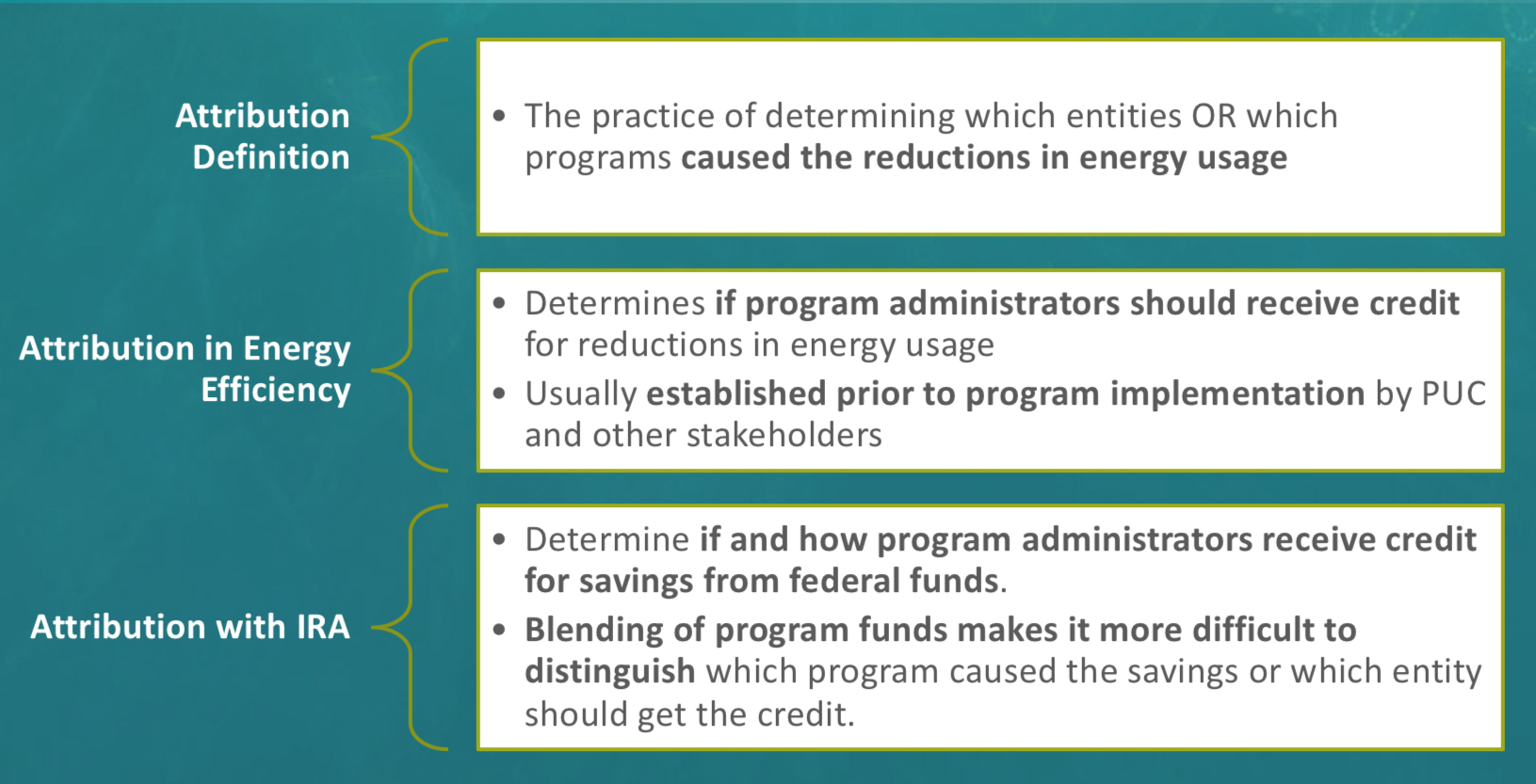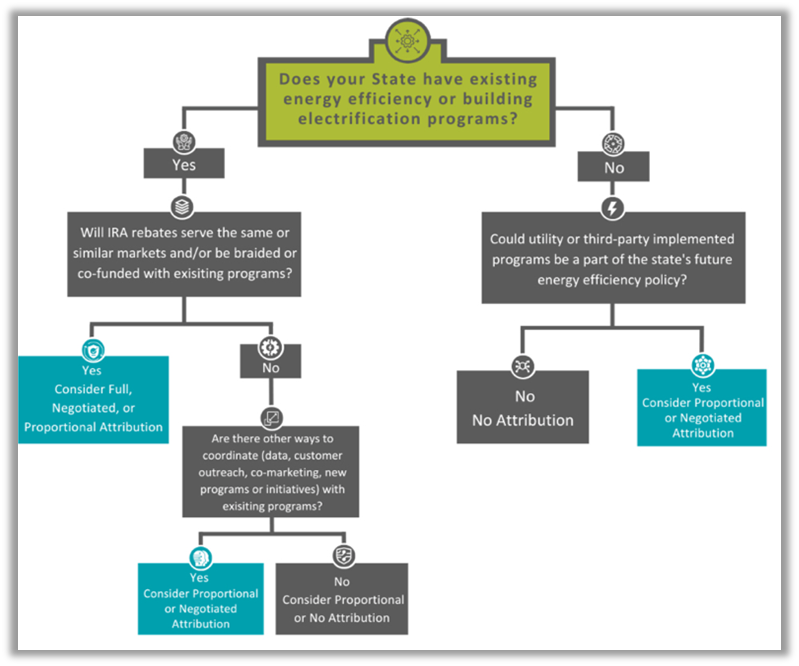

By Erin Cosgrove | Thu, September 26, 24
The Inflation Reduction Act (IRA) Home Energy Rebates offer opportunities for unprecedented investment in energy efficiency, electrification, and decarbonization of homes, allowing state energy offices to work with current energy efficiency program administrators to streamline program offerings and coordinate available resources.
While there are numerous benefits of braiding or co-funding regulated energy efficiency programs with IRA Home Energy Rebates, these efforts will require decisions about how to allocate or attribute the additional funding and savings generated by this new funding. Current energy efficiency programs have mandates to ensure their programs increase energy savings in the state. When new funding appears that addresses the same market, there is potential to contribute to or compete with existing programs. Whether this additional funding is seen as an opportunity or a barrier depends on how state energy offices and public utility regulatory commissions allocate or attribute the savings that flow from it. Therefore, alignment on how to attribute these additional savings and funding is key to enabling coordination.
To help states navigate these decisions, NEEP recently published Expanding the Energy Savings Pie: Attribution Frameworks to Align IRA Home Energy Rebates with Existing State Programs. This paper outlines four frameworks, or approaches, states can take to coordinate and allocate savings. This blog post outlines what attribution is, why it is instrumental to coordination efforts, and how states can leverage past examples and the NEEP frameworks to determine the best way to attribute savings and ensure coordination for their IRA Home Energy Programs.
What is Attribution?
Attribution is the practice of determining which entities or programs caused energy savings. Program administrators are attributed savings that result from implementation of their energy efficiency programs, such as when a rebate is provided to encourage a customer to replace electric resistance heating with a heat pump. Attribution can be complicated when combining funds because it is difficult to distinguish which funding stream resulted in the program achieving savings and how to value financial contributions versus non-monetary contributions, such as administrative support, marketing, relationships with trusted partners, or use of existing energy efficiency program infrastructure. But if a state does not address this issue, current program administrator resources and expertise could be left out of IRA Home Energy Rebates because of concerns that implementing programs will lower the savings attributed to them.
Attribution Unlocks Program Coordination
Attribution unlocks coordination because it alleviates fears of competition and enables states to tap into the existing program infrastructure, which can help to accelerate implementation of IRA Home Energy Rebates. Pulling all available funds under one program can save consumers money through lowering upfront costs. Coordinating programs under the same structure also provides opportunities to streamline involvement for administrators, contractors, distributors, and other market actors. This can create partnerships and resources that would still be available after the state has spent down IRA funding, ensuring stability and long-term market transformation beyond this infusion of new funding.
How to Determine Attribution When Braiding and Co-Funding Programs
Attribution is important but can be complicated when combining funds because it is difficult to distinguish which funding stream resulted in the program achieving savings. Past programs have tackled the issue of attribution when implementing the American Recovery and Reinvestment Act (ARRA), integrating new initiatives like support for compliance with building energy codes, and combining state-level programs to address low-income barriers. These examples can range from no attribution to full attribution of additional savings to something in the middle, with some states negotiating the attribution amount or only allowing for program administrators to receive a proportion of funds.
Each state that enacts IRA Home Energy rebates programs alongside current state programs will approach the issue differently. To help states start these discussions, NEEP created four attribution frameworks for states to use when deciding whether and how to attribute these additional savings. The four frameworks are presented below. You can read more about them and their application in our report, Expanding the Energy Savings Pie.
- Full Attribution: Program administrators receive all savings from programs that combine funding sources, provided program administrators meet any requirements or financial contribution thresholds set prior to implementation.
- Proportional Attribution: Program administrators receive proportional credit for savings associated with their financial contribution, which can include technical assistance, marketing, and administrative support, as agreed to prior to implementation.
- Negotiated Attribution: Program administrators receive a predetermined allocation of the savings from programs that blend outside funding with existing programs, provided program administrators meet certain requirements outlined prior to implementation. A negotiated approach enables program administrators to receive more savings than proportional, but could prevent an over-accumulation of savings, if that is a concern.
- No Attribution: Program administrators do not receive any savings attributed to external funding sources and do not play any role in implementing the programs funded.
Attribution Frameworks in Action
From past examples, states can gain insight into what framework is best for them and the types of program coordination that can be replicated with IRA Home Energy Rebate programs.
- Full Attribution is most often used when additional funding sources are brought in to try a new program design or add measures that did not previously exist. Full attribution can provide an incentive for coordination and lower the risk of piloting new program designs. Recently, states have allocated full attribution to utility programs that help administer and fund low-income programs in partnership with existing providers.
- Negotiated Attribution appears more frequently when program administrators are implementing new codes programs. For these programs, there is a set of conditions for program administrators to meet and an assigned value of savings that would be given. This approach can encourage program administrators to try new programs or measures with a lower risk of poor performance because they know in advance what they need to do to earn their allocation of savings.
- Proportional Attribution appears in some instances when funding streams are tied to two different mandates or if a separate third party implements the new programs and there are only a few instances where programs overlap. It is important to highlight that for IRA Home Energy Rebates, proportional attribution can run the risk of lowering the savings potential for current program administrators. For example, during ARRA Hawaii used proportional savings for its refrigerator program. ARRA provided a $200 incentive and program administrators provided $50. Therefore, program administrators received only 20 percent of the savings that resulted from every measure.
- No Attribution appears when outside funding sources have been used to create separate and distinct programs from the current program administrator’s portfolio. With no attribution, it is important to have two distinct programs so that participating customers and contractors are not forced to choose between rebates. During implementation of ARRA in New York, the state chose to not attribute savings and created its own program, which resulted in customers having to choose between rebates offered from the state and rebates offered by their utilities. This lowered the savings potential for program administrators in the state and created customer confusion on which rebates applied.
To learn more about the examples highlighted above see our report, Expanding the Energy Savings Pie.
Applying the Frameworks to Your State
States have been busy submitting their applications for IRA Home Energy Rebates, with multiple programs starting in the past month. Now is the time to have conversations on whether programs will coordinate and how new funding and savings will be allocated to existing energy efficiency program implementers. For examples of how to start this process, states can look at the memorandum from the Public Service Commission of Wisconsin, which outlines the four buckets and provides scenarios for the state to consider.
Having these conversations now can ensure that all resources come together to expedite and grow the impact of IRA Home Energy Rebates. To help states start this process NEEP’s report, Expanding the Energy Savings Pie provides a flowchart that outlines key decisions points. NEEP is also available to help identify which pathway works best given each state’s existing programs and future goals.



